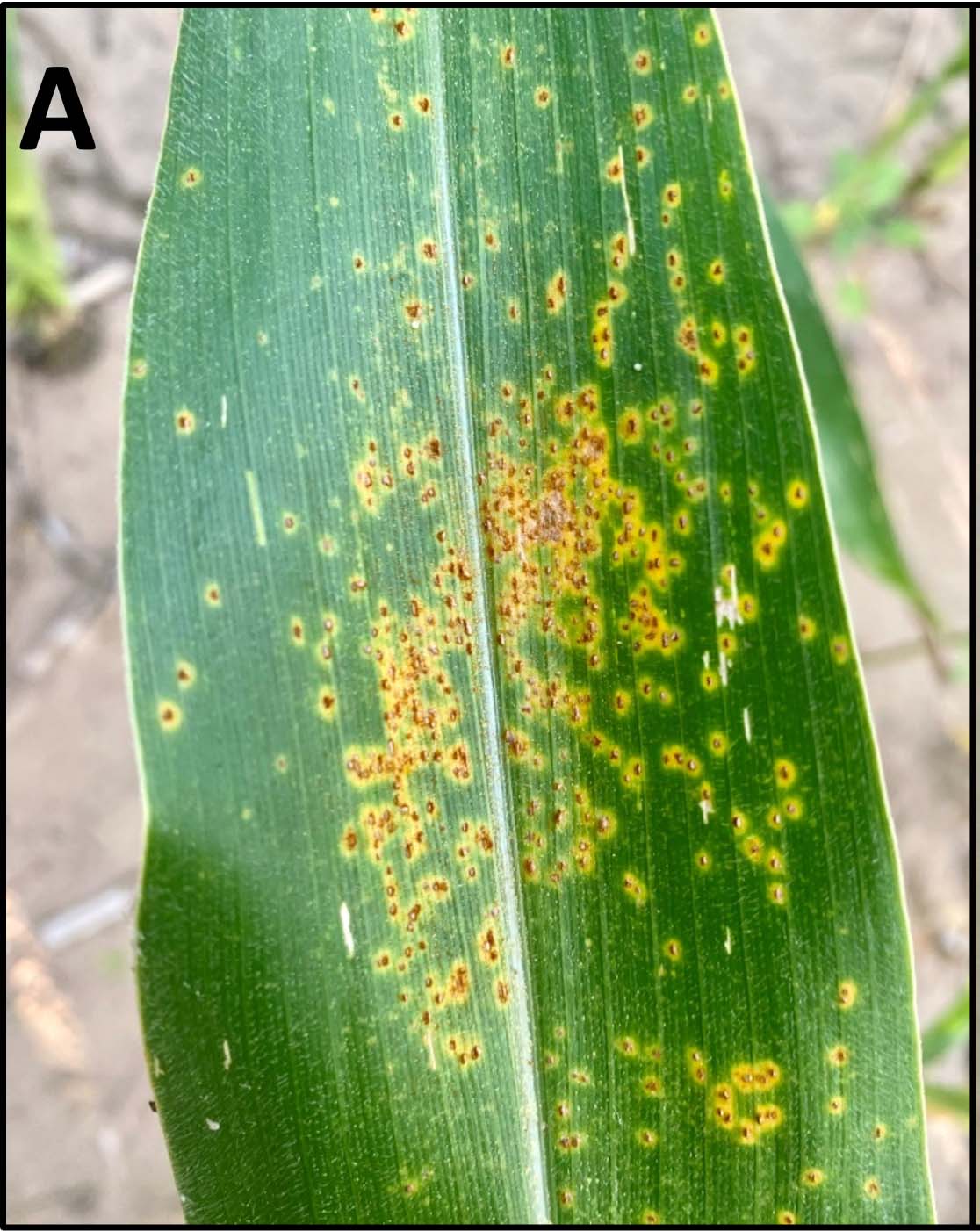Corn Disease Update
The disease known as Southern rust of corn was first reported on July 28th in a corn field in Tulsa County, Oklahoma (Figure 1A), with two more corn fields reported in Caddo County on July 31st. This year, Southern rust appears to be moving from eastern to western U.S. states, already reported in Florida, Louisiana, Alabama, and Arkansas, before appearing in Oklahoma. When weather conditions favor rust development, the infection cycle of this disease continually repeats, where the initial infections produce spores that are spread to nearby plants and fields. However, the impact that this disease is going to have in the corn fields is going to depend on several factors that need to be evaluated before making decisions regarding disease management, such as:
- Crop growth stage at the onset of infection: knowledge of the corn growth state when this disease arrives in the field is crucial for making decisions regarding disease management. Relevant information about the possible benefits that a fungicide application can have to protect the corn crop against Southern rust depending on the growth stage is available in a publication on the Crop Protection Network website. This research shows that the corn fields between the tasseling (VT) to milk growth stage (R3) when Southern rust is first detected may still benefit from a fungicide application if the weather conditions favor disease development. However, corn fields in the late milk, dough stages (R4) and beyond may not economically benefit from the fungicide spray. Although rust can appear in corn fields in late growth stages, yield losses caused by this disease may not be enough to warrant the cost of the fungicide spray.
- Corn hybrid susceptibility: knowledge of the corn hybrid regarding rust resistance is critical to determine the risk of the crop to yield and profitability losses. Consult your seed dealer to determine if your current hybrids have resistance against Southern rust.
- Weather conditions: the fungal pathogen that causes this disease, Puccinia polysora (Figure 1B), can infect corn plants after approximately six hours of leaf wetness. Despite the lack of rainfall, high relative humidity and long dew hours may provide enough moisture for the pathogen to cause infection. However, this disease is more severe and is more likely to cause yield losses in years with frequent rainfall events. Besides that, Southern rust is favored by temperatures around 80°F (27°C) that are easily reached through the corn growth season in the state.
My first recommendation for Oklahoma growers is to scout fields and look for symptoms of this disease in the corn leaves. The pathogen that causes this disease produces raised structures on the corn leaf surface called pustules that are orange to light brown in color, circular to oval in shape, and frequently surrounded by a light green halo (Figure 1A). I also recommend that the growers take notes regarding the position of the symptoms in the corn plant to identify where they are located, in the lower canopy (below ear leave) or upper canopy (upper part of the plant). After that, leave samples presenting symptoms of the disease should be sent to the Plant Disease and Insect Diagnostic Laboratory at Oklahoma State University since Southern rust can be mistaken with Common rust, a disease that is frequently observed in corn fields but is unlikely to cause yield losses.
Figure 1A. Southern rust pustules on the upper surface of the corn leaf.
Figure 1B. Southern rust spores called urediniospores observed under the microscope.
Another valuable resource that the corn growers have available is the Fungicide Efficacy for Control of Corn Diseases available in a publication on the Crop Protection Network website and presented in the table. This publication is updated annually, reporting the efficacy of the available fungicides to manage foliar diseases in corn, determined by field testing over multiple years and locations.
If you are curious to know if Southern rust is developing and moving across the U.S. corn production regions, we have an excellent website to track the disease's spread in real-time. The counties in each state marked in red are where Southern rust was already reported this year.
View the Fungicide Efficacy Control of Corn Diseases table. Source: Crop Protection Network.


